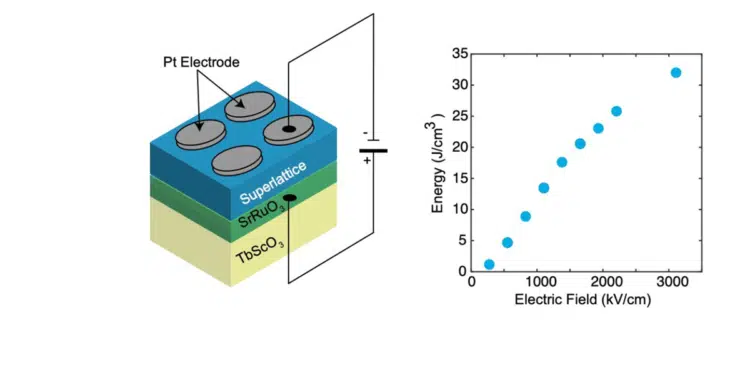Group of researchers from Cornell University, US propose a new lead-free antiferroelectric dielectric material made from bismuth, iron and oxygen as a suitable candidate for next generation of high energy capacitors.
The paper Published in Science Advances describes a new type of “antiferroelectric” material, which could be very useful in devices where quick storage or discharge of energy is needed – such as in defibrillators. But as yet, most antiferroelectric materials contain lead, making them less useful. In their paper, the researchers state that the material has a lot of potential to be a powerful capacitor.
Researchers demonstrated the use of electrostatic boundary conditions to liberate an otherwise metastable state of BiFeO3, which displays high-energy storage density; this value could potentially be further enhanced by tuning the dielectric constant of the neighboring layer to alter the stability of the antiferroelectric phase and tuning field. In the case of the new antiferroelectric/antiferromagnetic BiFeO3, an applied electric field could potentially turn on and off magnetism with the conversion to the ferroelectric/weak ferromagnetic BiFeO3 parent phase.
Abstract
Antiferroelectric materials have seen a resurgence of interest because of proposed applications in a number of energy-efficient technologies. Unfortunately, relatively few families of antiferroelectric materials have been identified, precluding many proposed applications. Here, we propose a design strategy for the construction of antiferroelectric materials using interfacial electrostatic engineering. We begin with a ferroelectric material with one of the highest known bulk polarizations, BiFeO3. By confining thin layers of BiFeO3 in a dielectric matrix, we show that a metastable antiferroelectric structure can be induced. Application of an electric field reversibly switches between this new phase and a ferroelectric state. The use of electrostatic confinement provides an untapped pathway for the design of engineered antiferroelectric materials with large and potentially coupled responses.
As shown in Figure 1.C, there is very little energy stored in a ferroelectric sample as the material is almost entirely saturated at zero bias. In the case of the antiferroelectric sample, however, there is almost zero polarization at zero field, and it has a much higher integrated storage capacity as depicted in Figure 1.D. Figure 1.E plots the stored energy as a function of applied electric field for the sample shown in Figure 1.D.
The average integrated energy plotted was computed from multiple polarization field hysteresis loops acquired over several individual capacitors on the sample. As shown, the sample reaches a peak of ~30 J/cm3 at a field of ~2.7 MV/cm. After this voltage, there is appreciable electrical leakage that prevents accurate calculation of the stored energy.
Tuning the dielectric layer in the sample alters the energy barrier between the antiferroelectric and ferroelectric phases and thus the switching field/stored energy. This highlights the extreme tunability of this system. This value of the stored energy density, 30 J/cm3, compares favorably to other perovskite systems that contain lead. It is also higher than the lead-free relaxor SrTiO3-substituted BiFeO3 thin films (~18 J/cm3) and BiFeO3/SrTiO3 superlattices (~12 J/cm3).






























